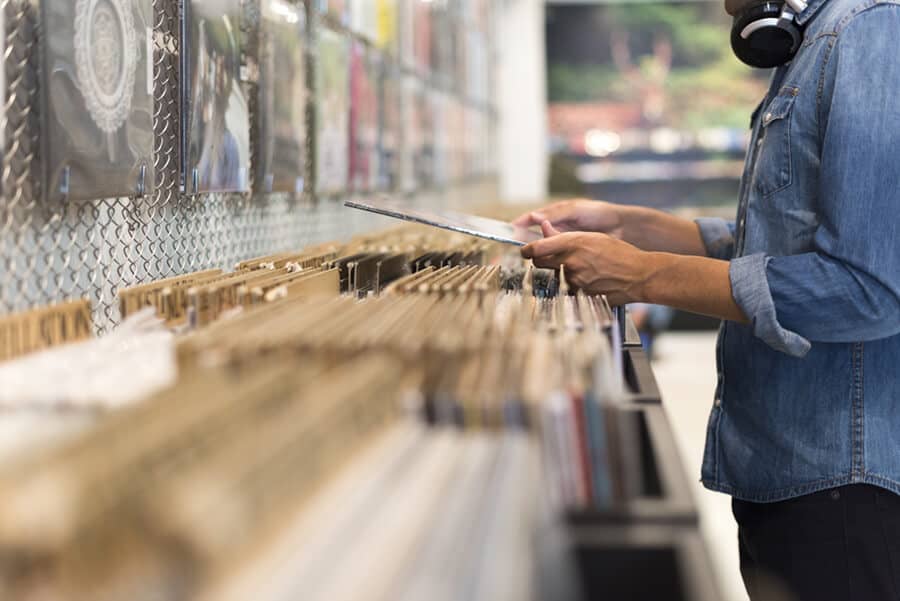In today’s modern society, the act of collecting and presently upholding physical memorabilia in music form comes as a subculture to standardize society. Painted as a hipster mindset, many edgy and out of the box individuals hold on to this textural historical entity while surrounding their lives on the vintage aesthetic. At the time, artists were gaining much, if not more, sales on physical copies sold than on streaming sites today. Because of the rapidly changing internet environment, one could argue that artists make LESS money now than ever before. So how should artists these days create a strong sturdy career doing what they love, without low financial profitability gain?
It’s interesting to think about how music has been played over the years. One like myself, could only imagine how it was playing heavy, thick, backyard blues on a huge southern record player. Or enjoying a tasty thick milkshake of a 1950’s diner to the sounds of a jukebox. It is safe to say, that the evolution of music sharing was necessary. As societies and cultures evolved and expanded, so did the desire for optimal listening experiences paired with the times.

I remember not too long ago, that feeling of walking into our neighborhood music store. As I opened the newly placed glass doors, I was hit with an authentic vintage aroma of velvet carpets and dusty vinyl records. The music store was my mecca. It was my home away from my comfy home. As I embarked on my epic journey into the land of musical wonderland, I could recall the broken CD cases placed so effortlessly in alphabetical order. I remember faintly holding the vinyl’s in my hand like a newborn baby. Its fragile skin held the true magic within. There is nothing better than having a piece of history, such as a vinyl or CD. Over time, the public became infatuated with the technological encyclopedia in the form of a cellular device we now know as smartphones. Through the expectancy and dependability of modern technology, the music-sharing has changed. From the humble beginnings of physical music sharing to the internet world in which music streaming bows its head in honor and gratitude, music listeners no longer want nor desire the products that artists so profoundly create for true authenticity. Why has society forgotten?
The Streaming Plague
Streaming media is the process of delivering media in a way that media is relieving and presented to an end user humbly delivered by a provider. Musical streaming sites such as Spotify, have scaled negative attention over the years. This reputation caused many mainstream artists such as “Taylor Swift”, “Justin Timberlake”, and “Shawn Mendes” to publicly forge opposite opinions of streaming and its effect on the music industry. What to remember, is although handy and accessible, streaming sites are businesses. The sole purpose is to benefit and expand further than their rival music services. According to Rolling Stones.com, music business schools British Phonographic Institute and Recorded Music Association of America, concluded that US recorded music grew 12% to $9.8 billion in 2018, by the workings of Spotify, Amazon Music, and Pandora. But in terms of the artists themselves, where does the money generate and go?

Record company Warner Music Group sheds light on the labels financial retaining compared to the artist retaining. It was suggested that there is a 25% average digital streaming royalty rate for the artists. But the money music listeners are spending on music platforms, do not land into the artists completely. A report from RIAA, showed that in 2018, 67.3% of the US record industry’s revenue total to $9.8 billion, $6.6 billion was paid to artists and labels. That means, 32.7% of the money earned went to the various streaming services. How does it happen? A factor would be the general understanding of streaming sites. Many people do not actually want to or see the value in purchasing albums and songs from the artist itself, because they find it cheaper to just stream! A substantial factor would be that Spotify agreed to lower from 55% to 52% the share of pro-rated net revenues received from the platform.
My first online music services used was iTunes. As I collected many musical artist and songs compiled onto my I Pod Nano, I felt a strong contribution to the various artist success. Partly, because to download the songs, you had to purchase every song, video, etc. entirely. Before I dived into the streaming platforms as an artist, I enjoyed the streaming services a lot. Because my technological skills are equivalent to a squirrel on a highway, the streaming sites were easy to operate for musical enjoyment. But once I began to starve for revenue made from my very own creations, I realized that much of my income flooded back into using the streaming sites as outlets. It is hard to say if I was able to create more financial attraction if I sold physical copies, but I doubt it. The additional problem is that consumers want the streaming sites. How was I truly able to stay competitive and hope of greater revenue, if I did not keep up with the masses?
Spotify and other platforms did not stop at their shadiness. In 2019, music streaming platforms rejected royalty rising efforts for songwriters in the United States. Negative publicity stormed the music outlets, as many artists, labels and songwriters found it a direct attack on the people who make the platforms possible.
In my humble opinion, it is important to research the various outlets your favorite artists are sharing their music and why. It is also important, to also see your favorite artist live! Much of the money these days come from merchandise and ticket sales for live concert events. The artists will and have humbly appreciated these efforts also because there is no better feeling than bringing your musical content to life on the live stage.
Another tip: Visit musicians’ websites!
Usually, artist will upload ways and different material to help the performer make a living doing what they love! It could be as simple as signing up for their email lists for in depth information on products and events happening for the artist to gain strong financial earnings. Overall, stream if you must, but research and find out how you can truly help your fellow artists the right way.
Photos: Shutterstock / Photomontage: Martina Advaney
More opinion pieces from the author:
Support us!
All your donations will be used to pay the magazine’s journalists and to support the ongoing costs of maintaining the site.
Share this post
Interested in co-operating with us?
We are open to co-operation from writers and businesses alike. You can reach us on our email at cooperations@youthtimemag.com/magazine@youthtimemag.com and we will get back to you as quick as we can.










